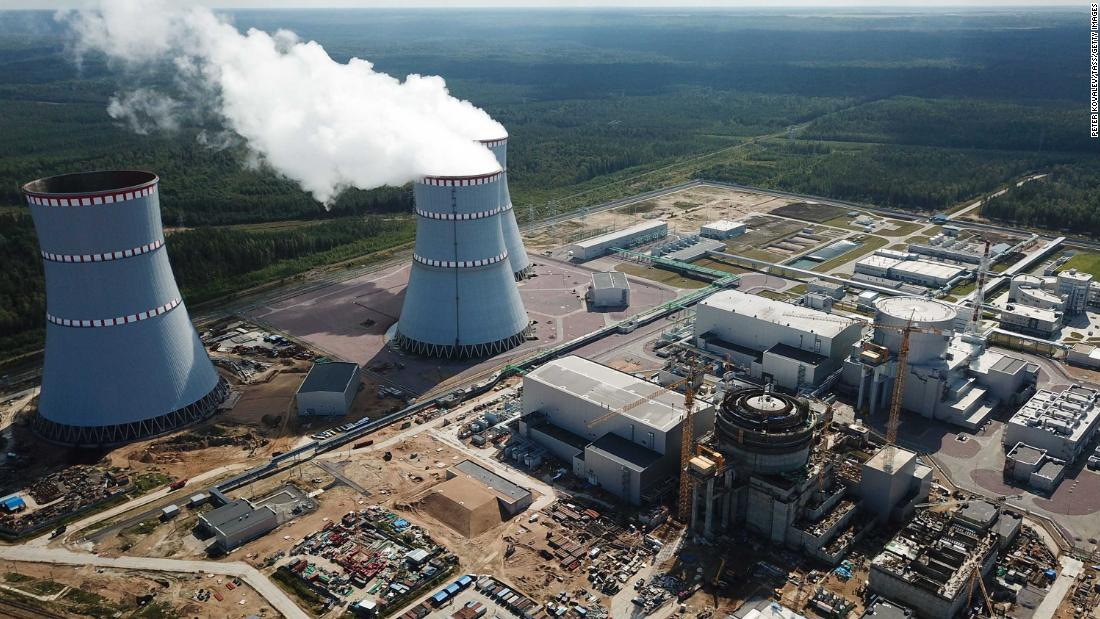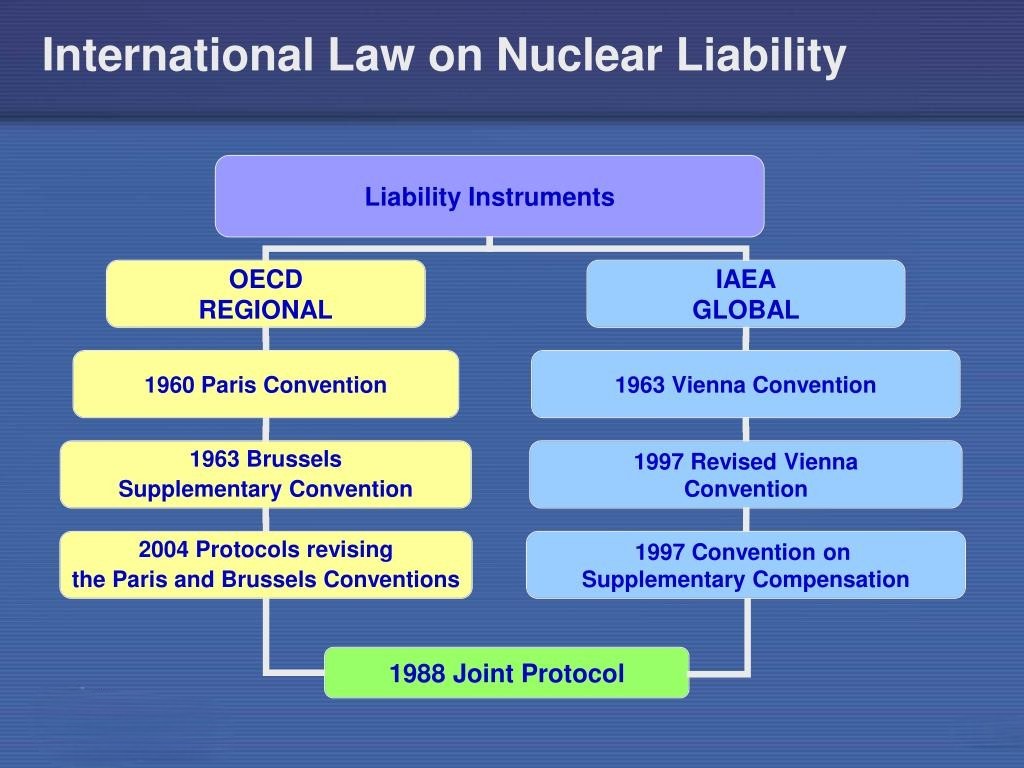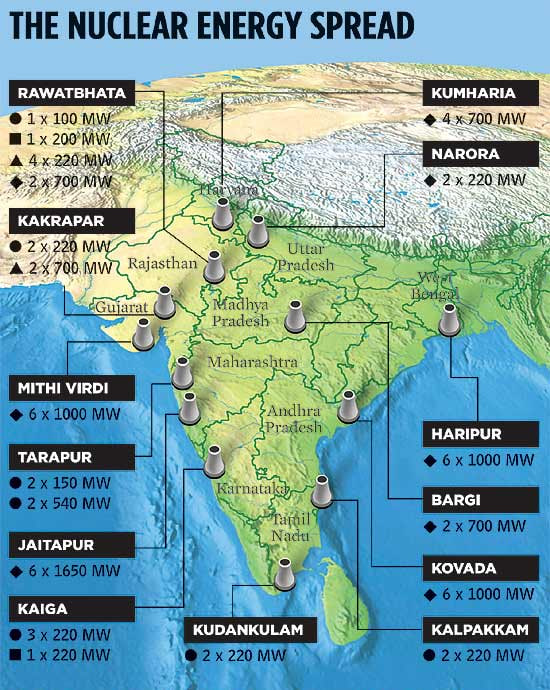Description

Copyright infringement not intended
Context: Concerns about India's nuclear liability law keep hampering a more than a decade-old plan to develop six nuclear power reactors in Maharashtra's Jaitapur, the world's largest nuclear power generation site under consideration at present.
Nuclear Liability Law
About
- Nuclear liability law is a branch of law that deals with the legal consequences of a nuclear incident or disaster.
- A nuclear incident is an event that causes significant damage to persons, property or the environment due to the release of radioactive material or ionizing radiation from a nuclear installation or a nuclear transport.
- It aims to provide compensation to the victims of nuclear damage and to allocate the responsibility for paying such compensation among different parties.
Objectives
- To ensure that adequate compensation is provided to the victims of a nuclear incident.
- To protect the operators of nuclear facilities from unlimited and unpredictable liability claims.
- To promote nuclear safety by creating incentives for operators to adopt high standards of care and prevention.

Principle of nuclear liability law
- Two main principles underlie nuclear liability law: Strict liability and exclusive liability.
- Strict liability means that the operator of a nuclear facility is liable for any damage caused by a nuclear incident, regardless of fault or negligence.
- Exclusive liability means that only the operator can be held liable for a nuclear incident, and no other person or entity can be sued for compensation.
- Only the operator can be sued for nuclear damage, and not any other person or entity involved in the nuclear activity, such as the supplier, the manufacturer, the transporter, or the government.
- The operator's liability is capped at a certain amount, which varies depending on the country and the convention.
- For example, in India, the Civil Liability for Nuclear Damage Act 2010 sets the operator's liability at ₹1,500 crores, while in France, it is €700 million under the Paris Convention.
- The limitation of liability also applies to the period within which claims for compensation can be made. For example, in India, claims must be filed within 10 years of the incident, while in France; it is 30 years under the Paris Convention.
- Exclusive jurisdiction of the courts of the country where the nuclear incident occurred. It aims to avoid conflicting judgments and ensure uniform application of the law. For example, in India, only Indian courts have jurisdiction over nuclear damage claims.
International Conventions on nuclear liability
- Nuclear liability law is not uniform across the world. Different countries have adopted different national laws and regulations on nuclear liability, and some have also joined international conventions that establish common rules and standards on nuclear liability.
- Some of the most important international conventions on nuclear liability are:
- The Paris Convention on Third-Party Liability in the Field of Nuclear Energy (1960) and its supplementary protocols
- The Vienna Convention on Civil Liability for Nuclear Damage (1963) and its supplementary protocols
- The Convention on Supplementary Compensation for Nuclear Damage (1997)
- The Joint Protocol Relating to the Application of the Vienna Convention and the Paris Convention (1988)
- These conventions aim to harmonize the national laws of their contracting parties and to provide a framework for international cooperation and mutual assistance in case of a nuclear incident.
- They also set minimum amounts of liability coverage that operators must have, and establish mechanisms for compensating damage that exceeds those amounts.

Nuclear liability legislation in India
About
- Nuclear energy is a promising source of clean and affordable power, but it also poses significant risks to human health and the environment in case of a nuclear accident.
- India has been pursuing nuclear energy for civil purposes since the 1950s and currently has 22 operating nuclear reactors and seven under construction.

Background
- The International nuclear liability framework is made up of several accords that were strengthened following the 1986 Chornobyl nuclear disaster.
- In 1997, the Convention on Supplementary Compensation (CSC) was adopted to establish a minimum national compensation level.
- If the national amount is insufficient to pay for the damage caused by a nuclear incident, the amount can be increased further through public funds (to be made available by the signing parties).
- India is a signatory to the CSC and the convention adopted by Parliament in 2016.
- To comply with the international convention, India implemented the Civil Liability for Nuclear Damage Act (CLNDA) in 2010, which established a rapid compensation process for nuclear accident victims.
Civil Liability for Nuclear Damage Act (CLNDA)
- India is one of the few countries in the world that has a nuclear liability law that holds the suppliers of nuclear equipment and services liable for any nuclear accident.
- The Civil Liability for Nuclear Damage Act, 2010 (CLNDA) was enacted by the Indian Parliament after the 2008 Indo-US nuclear deal to facilitate the entry of foreign nuclear companies into the Indian market.
- It aims to provide a speedy compensation mechanism for victims of nuclear damage and to allocate liability among various parties involved in a nuclear incident.
Main features of the CLNDA
- Liability of the operator: It limits the liability of the operator of a nuclear installation to Rs. 1500 crore for each nuclear incident.
- The operator has the right to recourse against the supplier if the nuclear incident is caused by defective equipment or material, or by gross negligence or willful act of the supplier or its employees.
- Role of Government: It allows the central government to assume full or part of the liability of the operator or to increase the liability amount, as well as to create a nuclear liability fund by charging a levy on the operators.
- Nuclear Damage Claims Commission: It establishes a Nuclear Damage Claims Commission (NDCC) to adjudicate claims for compensation arising from a nuclear incident.
- The NDCC can award compensation for loss of life, personal injury, property damage, economic loss, environmental damage, and preventive measures.
- Strict liability: It provides for strict and no-fault liability of the operator, meaning that the operator is liable regardless of fault or negligence. The claimants do not have to prove any causal link between the nuclear incident and the damage suffered.
- Limited time: It sets a limitation period of 10 years for filing compensation claims, except for claims related to personal injury, which can be filed within 20 years.

Challenges
- Strict liability of the Operator: The CLNDA violates the principle of legal channelling of liability, which stipulates that only the operator of a nuclear installation should be liable for nuclear damage.
- It exposes the suppliers to unlimited and indefinite liability, which may deter them from entering or investing in the Indian nuclear market.
- Inadequate Compensation: The CLNDA does not provide an adequate amount of compensation for victims of a nuclear accident. The liability cap of Rs. 1500 crore is much lower than the international standards, which range from $300 million to $1.5 billion under various conventions.
- Not Comprehensive: The CLNDA does not cover all types of damages that may result from a nuclear incident, such as psychological harm, social impact, cultural loss, and punitive damages.
- Lengthy process: The CLNDA does not ensure a speedy and fair settlement of compensation claims.
- The NDCC may face challenges in determining the quantum and distribution of compensation, as well as in dealing with multiple and conflicting claims.
- The NDCC may also be subject to political interference or judicial review, which may delay or hamper its functioning.
- The CLNDA does not provide an effective mechanism for enforcing the awards of compensation against the operators or suppliers.
- Low Compensation: The operator's liability cap is too low compared to international standards and does not reflect the potential magnitude and severity of a nuclear accident.
- Cover Limited Damage: The definition of nuclear damage is narrow and does not include environmental damage, preventive measures or punitive damages. It also excludes any damage occurring after a period of 10 years from the date of the nuclear incident.
- No provision for arbitration: The jurisdiction of Indian courts is exclusive and does not allow for alternative dispute resolution mechanisms such as arbitration or mediation.
Initiatives need to be taken
- Reviewing and revising the operator's liability cap to make it more realistic and commensurate with international norms and best practices.
- Clarifying and harmonizing the right of recourse provisions with international conventions and bilateral agreements.
- This could involve limiting the right of recourse to cases of intentional or gross negligence by the supplier or incorporating contractual waivers or indemnities between the operator and the supplier.
- Expanding and updating the definition of nuclear damage to include environmental damage, preventive measures and punitive damages. This could also involve extending the limitation period for filing claims beyond 10 years.
- Allowing for alternative dispute resolution mechanisms such as arbitration or mediation to resolve disputes arising out of nuclear incidents. This could help expedite the compensation process and reduce litigation costs.
- Strengthening and ensuring the independence and competence of the NDCC. This could involve appointing him or her from a panel of experts nominated by an independent body such as the judiciary or the regulator.
Conclusion
- India's nuclear liability law is a crucial piece of legislation that affects not only India's domestic nuclear sector but also its international relations and reputation. It is therefore imperative that India reviews and reforms its nuclear liability law to make it more consistent, transparent and effective. This would not only enhance India's nuclear safety and security but also boost its confidence and credibility as a responsible nuclear power.
Must Read Articles:
Civil Liability for Nuclear Damage: https://iasgyan.in/daily-current-affairs/civil-liability-for-nuclear-damage
Nuclear Power in India: https://www.iasgyan.in/daily-current-affairs/nuclear-power-in-india
|
PRACTICE QUESTION
Q. What are the main challenges and implications of implementing the Civil Liability for Nuclear Damage Act, 2010, in India, especially with regard to the supplier liability clause and the international conventions on nuclear liability?
|

https://epaper.thehindu.com/ccidist-ws/th/th_delhi/issues/34046/OPS/GIGB5KQ48.1+GMMB5L14C.1.html













